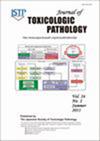对枯基苯酚对大鼠新生儿囊性肾发育的可能临界给药期
IF 0.9
4区 医学
Q4 PATHOLOGY
引用次数: 0
摘要
根据先前关于从出生后第4天(PND)开始给大鼠新生儿服用对枯基苯酚(PCP)18天时诱发囊性肾的报告,3只大鼠新生儿每天给药一次,持续14天,分别来自PND 14、21、28、35或42组,分别为W2、W3、W4、W5和W6组,以研究不同PND的给药期是否影响囊性肾小管的发育。W2组病变明显,W3组病变程度较轻,而在PND28之后开始给药时,任何一个肾脏都不受影响。这些发现以及先前研究的结果表明,PND 14-28是PCP在大鼠新生儿中发展为囊性肾脏的关键给药期。AQP2免疫组织化学染色阳性。这一发现和解剖位置表明囊性小管起源于集合管。衬里上皮的阻塞、液体积聚或修复性增生不太可能参与由具有高核密度的单层立方或柱状上皮衬里的囊性小管的形成。因此,对PCP的随访研究表明,在大鼠新生儿中,PND14-28是肾集合管囊性扩张的关键给药期。这项研究进一步支持了上皮细胞的附加性增生是这种独特病变的基本基础。本文章由计算机程序翻译,如有差异,请以英文原文为准。
A possible critical dosing period of p-cumylphenol for development of cystic kidneys in rat neonates
In accordance with a previous report on cystic kidneys induced in rat neonates when dosed with p-cumylphenol (PCP) for 18 days from postnatal day (PND) 4, 3 rat neonates were dosed with PCP once a day for 14 days, either from PND 14, 21, 28, 35, or 42 as W2, W3, W4, W5, and W6 groups, respectively, to investigate whether dosing periods in different PNDs influenced the development of cystic renal tubules. The lesion was striking in the W2 group and at a lesser magnitude in the W3 group, whereas either kidney was unaffected when dosing was initiated beyond PND 28. These findings, together with the results from the previous study, suggested that PND 14-28 is a critical dosing period for PCP to develop cystic kidneys in rat neonates. The lining epithelium of the cystic tubules was immunohistochemically positive for AQP2. This finding and the anatomical location indicated that the cystic tubules were of collecting duct origin. Either obstruction, fluid accumulation, or reparative hyperplasia of the lining epithelium was unlikely to be involved in the formation of cystic tubules lined with a monolayer of cuboidal or columnar epithelium with a high nuclear density. Thus, the follow-up investigation on PCP suggested a critical dosing period of PND 14-28 in rat neonates for the development of cystic dilation of renal collecting ducts. This study further supports that additive hyperplasia of the lining epithelium is a fundamental basis of this unique lesion.
求助全文
通过发布文献求助,成功后即可免费获取论文全文。
去求助
来源期刊

Journal of Toxicologic Pathology
PATHOLOGY-TOXICOLOGY
CiteScore
2.10
自引率
16.70%
发文量
22
审稿时长
>12 weeks
期刊介绍:
JTP is a scientific journal that publishes original studies in the field of toxicological pathology and in a wide variety of other related fields. The main scope of the journal is listed below.
Administrative Opinions of Policymakers and Regulatory Agencies
Adverse Events
Carcinogenesis
Data of A Predominantly Negative Nature
Drug-Induced Hematologic Toxicity
Embryological Pathology
High Throughput Pathology
Historical Data of Experimental Animals
Immunohistochemical Analysis
Molecular Pathology
Nomenclature of Lesions
Non-mammal Toxicity Study
Result or Lesion Induced by Chemicals of Which Names Hidden on Account of the Authors
Technology and Methodology Related to Toxicological Pathology
Tumor Pathology; Neoplasia and Hyperplasia
Ultrastructural Analysis
Use of Animal Models.
 求助内容:
求助内容: 应助结果提醒方式:
应助结果提醒方式:


